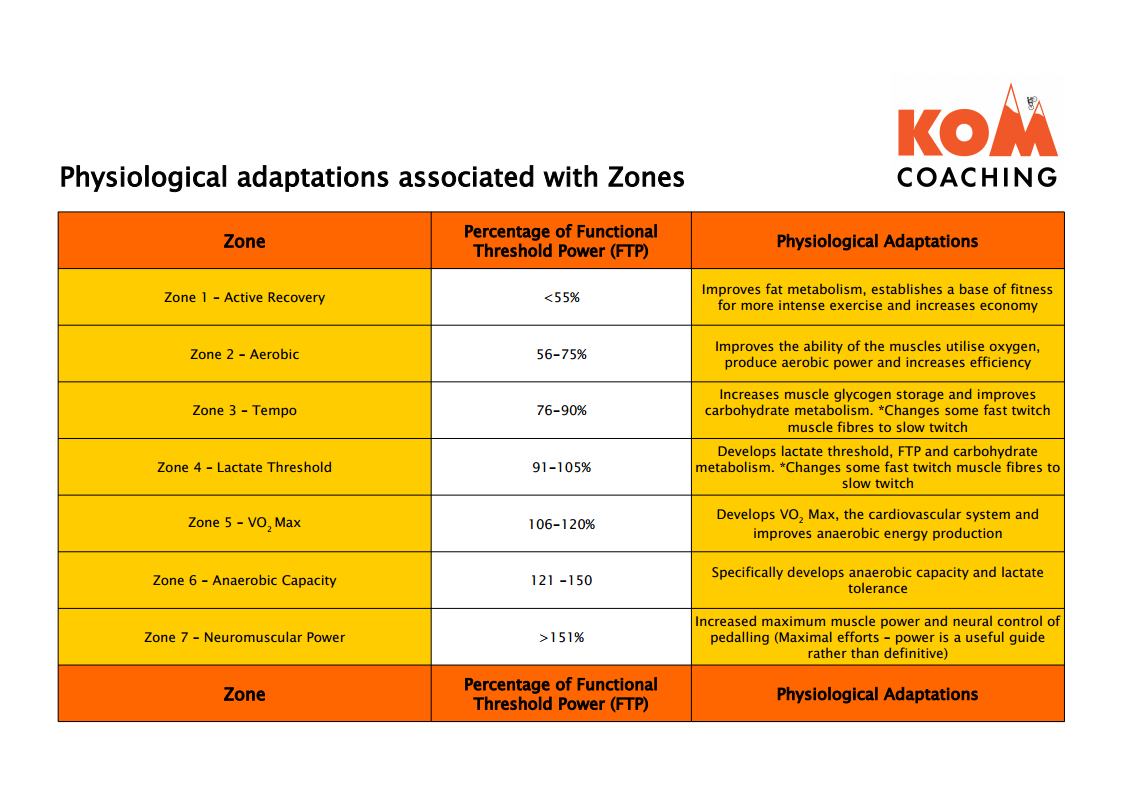Why train in zones?
Intensity levels or training zones are one of the best training tools out there – in a nutshell working at a given intensity, or zone will bring about specific physiological adaptations. (see ‘Physiological adaptations associated with Zones’). For instance working more in zone 2 will improve our basic endurance and cardiovascular fitness – or more specifically it improves the ability of the muscles utilise oxygen, produce aerobic power and increases efficiency. By targeting certain zones we can focus on the areas we need to improve and make the most efficient use of our valuable training time.
Power is better than Heart Rate
Many people train with a heart rate monitor. This is a simple and fairly accurate way to help gauge our effort level, or tell us which zone we are training in, but is far from perfect. Heart Rate Monitors measure your body’s response to effort – how much stress it is under – rather than how much power you are actually delivering. There are a couple of significant problems with this. Firstly lots of things put stress on the body and thus affect heart rate, things such as fatigue, hydration and temperature. This means that you can’t be sure that you are putting in the same effort whenever your heart rate is at a given level, or in a particular zone. Your heart rate might be higher because it’s hotter, you’re less well hydrated, or for any of a number of reasons. Secondly heart rate is relatively slow to respond to an effort, meaning that you can be working in zone 5 for instance, but heart rate takes a while to catch up and doesn’t reflect this effort. There is a time lag associated with heart rate that means it may appear that you have spent less time in a certain zone. For short, intense efforts, your Heart Rate Monitor might not register time spent in higher zones at all!
Power is a direct measurement of your output – it gives an objective measure of your performance. Irrespective of the wind, the weather, the surface, the terrain, which bike you are riding, how tired or dehydrated you are, it measures precisely how hard you are pushing and how fast you are pedalling to give your power output in Watts. Just for clarity, Power is the rate at which work is done, or Power = Work / Time. In other words the power meter tells you exactly how well (or badly) you are going. It is also a much more accurate way to determine which zone your are working in and thus which physiological, metabolic or neuromuscular systems you are stressing and ultimately improving.
Indoor Cycling Workouts for Ultimate Control
Most people enjoy the freedom of riding in the great outdoors, but the roads, junctions, even tiny variations in gradient and terrain mean that our effort level is constantly fluctuating on these rides. Riding outdoors, or riding as we feel, is like a scatter gun approach to training – some of the time is useful in developing certain abilities but much of our valuable training time is wasted.
It so much easier to ensure that you train at exactly the right intensity on an indoor trainer. The fact that there’s no rest, no traffic, no unwanted variations in gradient or interruptions mean that you can do a quality workout in less time than on the road. If you are serious about your training, or pressed for time (who doesn’t have to juggle work, family and the rest of life along with their training?) then indoor cycling workouts are ideal. We can use the ultimate control of an Ant+ FE-C enabled trainer (such as many Tacx trainers, Bkool and lots more) to control exactly how many Watts we are producing, so that we can be sure that we train precisely in the relevant zone(s) to target specific training effects. This is the ultimate way to get the most out of every second of your valuable training time.
Indoor training is great for controlled workouts which use your time efficiently. The incredible functionality and precise control afforded by the Indoor Cycling Workout app takes it one step further – giving you the ultimate control over the intensity of your workout so that you can train smarter!
Article written by Martin Burrows – British Cycling level 3 and Training Peaks Level 2 Certified Coach

